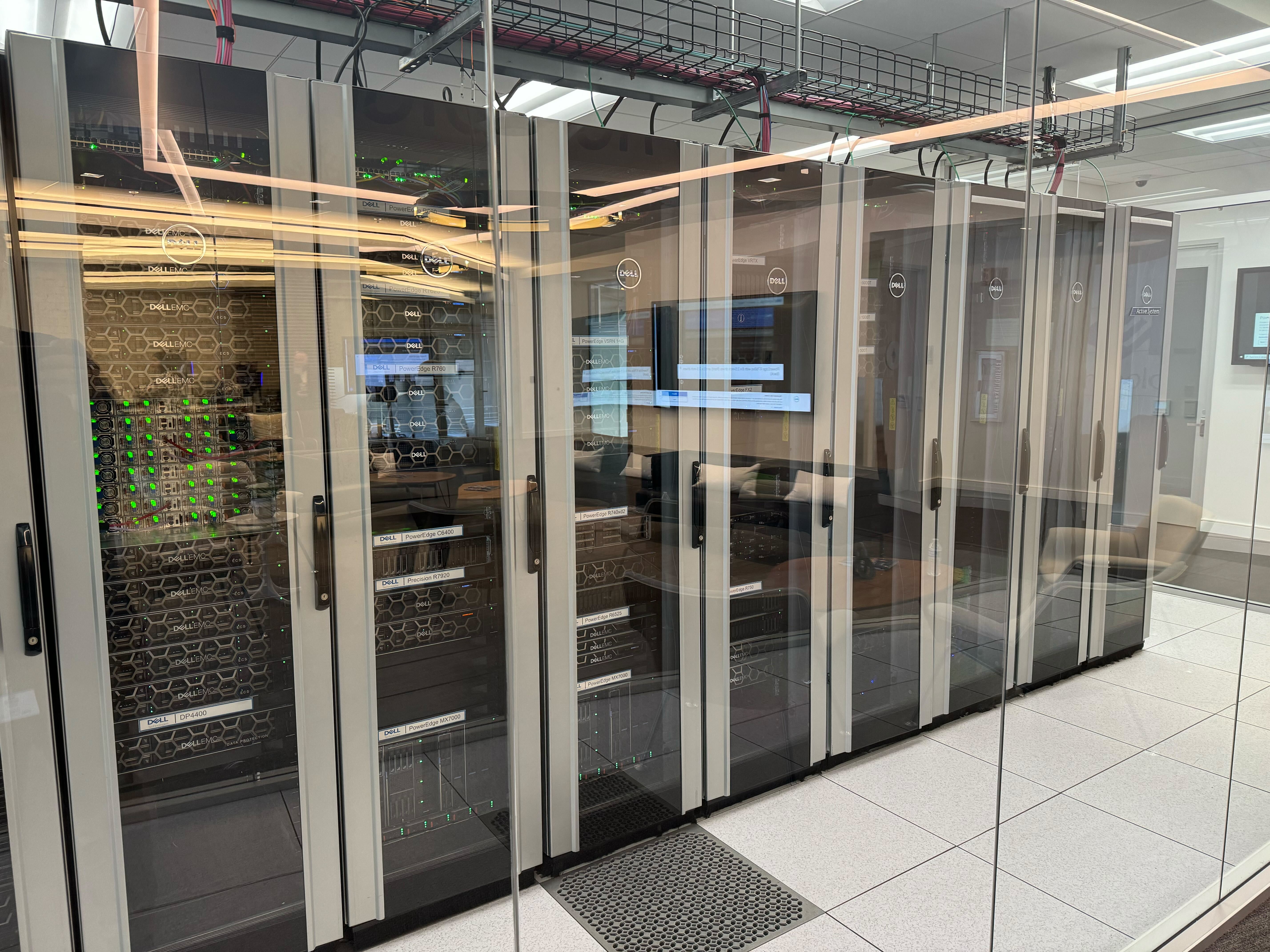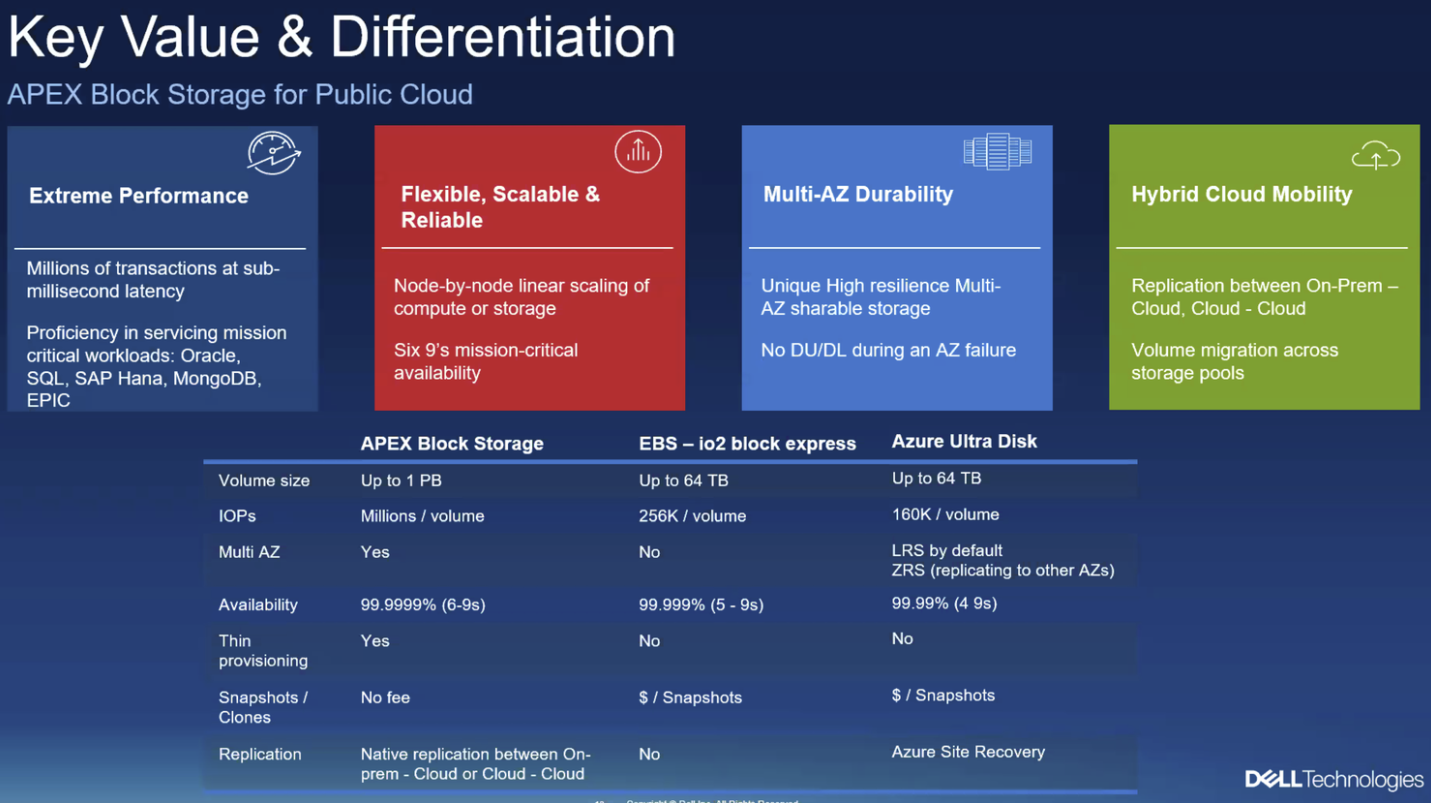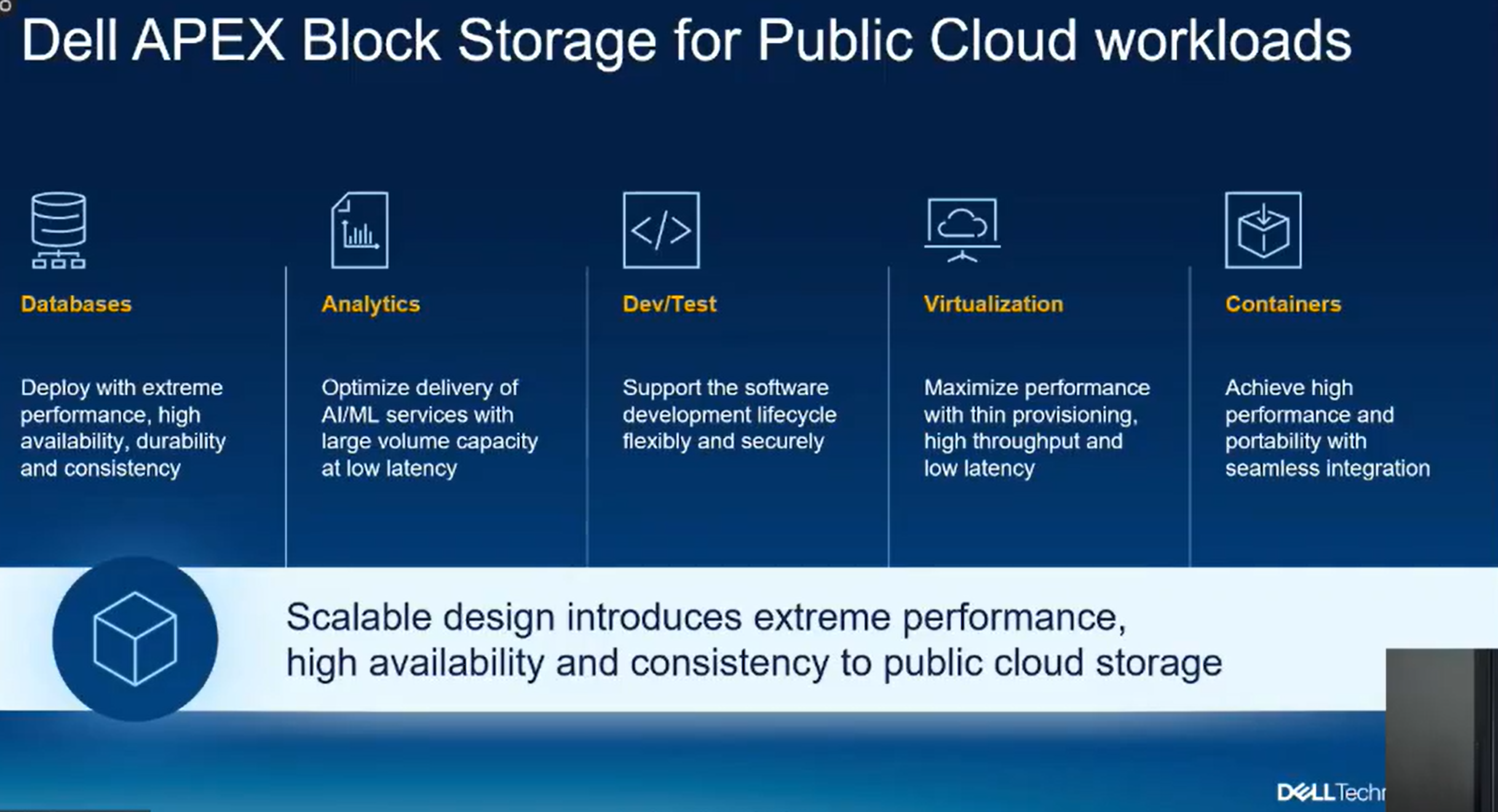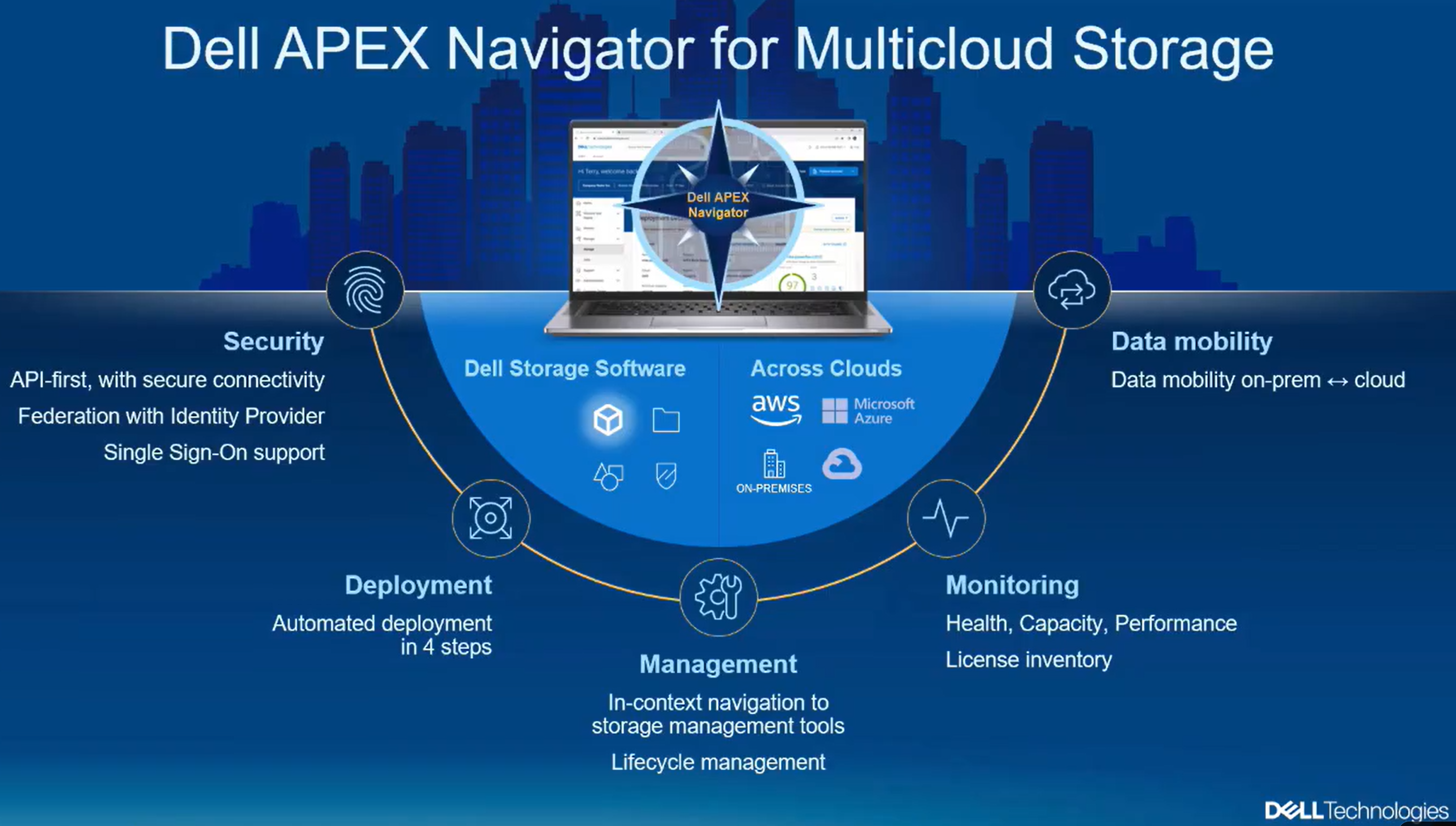Day 2 of Cloud Field Day kicked off at Dell’s offices here in Santa Clara, which is a very nice Executive Briefing Center. It’s been a while since I’ve seen some Dell hardware, unfortunately I wasn’t able to get behind the glass to give these guys a hug.
Dell started their presentation with Prateesh Sharma laying the groundwork for multi-cloud, and the important of a universal storage layer for companies who are trying to manage and operate across multiple environments.
A few new terms for me were “ground to cloud” and “cloud to ground”. “ground to cloud” aiming at the concept of taking technologies and learnings from on-premises environments and solutions to the public cloud environments, and vice-versa for “cloud to ground”.
After level setting, Prateesh introduced a new product line known as APEX, specifically APEX Console and Navigator, which provides insights, configuration, orchestration and control for your multicloud storage.
APEX Block Storage for Public Cloud
The idea of creating a storage array in a public cloud environment by leveraging virtual machines and underlying storage isn’t a new concept. Whether or not you need it is the primary question you should be asking.
Dell outline the drivers for looking at APEX Block Storage are along the lines of:
- Extreme performance
- Flexible, scalable, and reliable storage
- Multi availability zone durability
- Hybrid cloud mobility
Kiruthika Gopal, the Product Manager for APEX Block Storage for Public Cloud, walked us through the APEX Block Storage solution, and what that looks like when deployed to AWS or Azure.
At a high level, there are two offerings:
- Balanced - Deploying on EC2 / Azure VMs and attaching EBS / Azure premium disk
- Performance optimizaed - Utilises EC2 instance stores, or Local attached NVMe SSDs in Azure, aggregates the instance storage and create a cluster
The solution is available via the marketplace, or from Dell directly, which is nice to have options from a procurement perspective, especially if you need to draw down on your cloud credits.
Dell noted they are not necessarily aiming to compete with the public cloud storage offerings, but instead elevate the experience, and provide storage for performance and scalability that might otherwise not be available with native public cloud solutions.
What sort of workloads do Dell see you leveraging APEX Block Storage for?
It’s worth noting 10TB usable capacity is the minimum deployment size for APEX Block Storage, and commercially is available on 1 year and 3 year subscriptions. The pricing is based on storage capacity and number of storage nodes required for the solution.
And you’d expect from a block storage solution from a major storage provider, there are also capabilities built in to the platform to support replication and snapshot mobility, providing flexibility to move your data from on-prem to this cloud based storage solution, which also provide the underlying support for business continuity and disaster recovery capabilities.
What does the deployment look like? Thankfully it’s all automated and you don’t need to worry about standing up the infrastructure in the public cloud environment, or running any complicated scripts. You input the IOPS and Capacity requirements to APEX Navigator, and it will deploy the solution.
“What is APEX Navigator?” I hear you ask. Well …
APEX Navigator for Multicloud Storage
What we spoke about so far was APEX Block Storage for Public Cloud, which is the specific storage product, but to manage that you’d look to leverage APEX Navigator.
Navigator is a SaaS based tool, which provides centralised management for Dell storage deployed across public cloud environments. During some Q&A as we unpicked a few things, it became evidant that Navigator is an additional cost on top of APEX Block Storage, specifically the cost is based on per terrabye of storage on the systems it is managing, and while you could deploy APEX Block Storage without Navigator, you probably wouldn’t do it.
Oh, and Navigator only supports deployments to AWS today. I’m sure support for the other cloud platforms will be coming soon.
Navigator is accessible via the web browser as a GUI based tool, or as per most solutions these days, there is an API available if you wanted to call Navigator programatically. This also means you can use Infrastructure as Code, to untimately provision and manage your Dell cloud storage solutions. The Provider is here if you’re interested.
Using Navigator, the provisioning process for an APEX Block Storage solution seemed to be relative straight forward, which Dell demo’s during the presentation:
- Select storage product and target cloud
- Select or add cloud access
- Select deployment configuration
- Review and deploy
To finish up, Dell walked us through a demonstration to highlight the resilience of the solution when deployed across multiple availbility zones in the cloud platform.
APEX Cloud Platform
Finishing up the morning for Dell, things were flipped on their head as we now took a look at the “cloud to ground” part of Dell’s story. Everyone loves the public cloud, right, and they want to bring those same patterns, practices, and operating models to on-premises.
Dell walked us through APEX Cloud Platform, which as simply as I can put is a turnkey solution for deploying on-premises “private clouds”, such as Azure Stack HCI, RedHat OpenShift, and VMware. They’ve taken Lessons learned from vxrail management, and built it in to APEX Cloud Platform Foundation Software, and as you’d expect, the solutions arun on Dell MC nodes, and are centered around using Dell SDS storage.
The key takeaway for me is around the simplicity of day 0 operations, as well as built in lifecycle management, but also the integration they’ve built in to the tooling, to save you having to chop and change between different management interfaces. Their goal is to make the life of an administrator easier, not more difficult, and from what they showed today, I would have loved something like this when I was managing on-prem infrastructure.
I originally thought this was aiming to be a management plane to manage workloads in public and private cloud environments, which I was already groaning at as I haven’t seen this done well outside of IaaS integrations. But thankfully, my initial instinct was wrong, and this is effectively a solution to deploy and manage three specific on-prem solutions more effeciently.
I’m not bought in to the “cloud to ground” notion specifically that Dell were putting forward. To me that would be more along the lines of having a more holistic private cloud solution providing the ability to deploy, scale, manage, and consume workloads. This isn’t that, though. But if you’re a Dell customer looking to deploy Azure Stack HCI, RedHat OpenShift, or VMware solutions on-prem today, centered around Dell Hardware, APEX Cloud Platform is worth a look.



